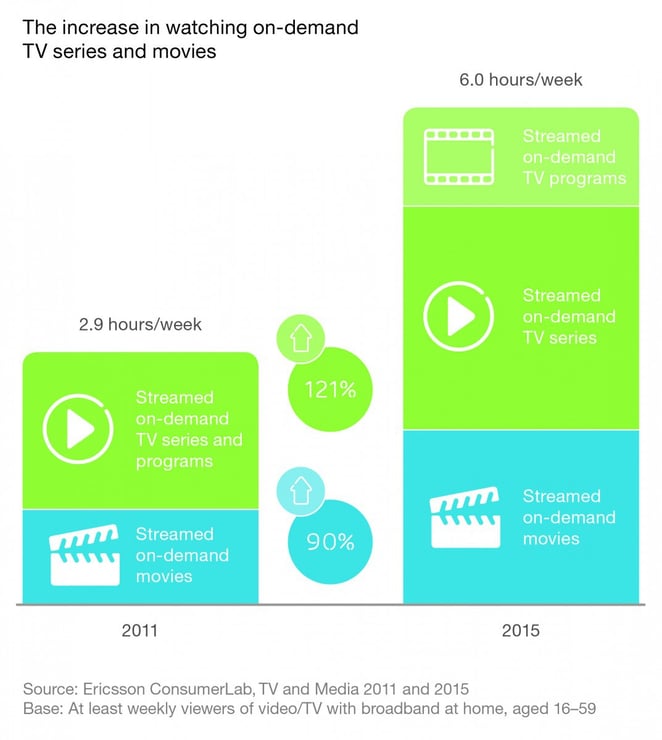Television is a wonderful thing. Not only does it help keep us up to date with what’s happening in the world, it also offers us a real sense of escapism from our everyday lives - simply put, TV is an institution. Traditional TV has been hugely popular for decades, but the way in which we consume our visual content has evolved in recent times - particularly since the introduction of on-demand video (VoD).
What VoD numbers say?
Ericsson's ConsumerLab TV & Media Report 2015 unveiled an interesting behavioral change. Consumers now spend six hours per week watching streamed on-demand video (series, programs, or movies) – which is more than double compared to 2011. By adding the recorded and downloaded content, nowadays 35% of all video viewing is spent on VOD.
Other stats:
- According to a recent survey carried out by HIS (see infographic), Brits are watching less TV than ever, with the average person watching just over three hours of television per day (a 14 minute drop per person since 2013).
- In another revealing piece of research conducted by none other than Ofcom, an eye opening 6 in 10 adults have tuned into video on-demand services within the last 12 months - a real sign of the times. In the UK, BBC iPlayer is by far the most popular VoD (video on-demand) service in terms of major broadcasters, with ITV, All 4 and Sky not too far behind.
What does that mean?
All of these findings seem to indicate one key conclusion: VoD is putting the muscle on the traditional TV format. What this means is, as technology advances, so does the way in which people live their lives. With the prominence of smartphones, tablets and other such devices (that have all now become a staple part of our everyday lives), and with the average lifestyle becoming increasingly hectic, humans need a certain level of flexibility with their schedules; VoD caters for that.
While the rigid format of traditional TV was once much loved, people no longer want to be told when and where they can watch their favourite films or programmes, nor do they necessarily want to wait for the next installment of their beloved drama or sitcom. In today’s world people want results; they want answers - and they want them now.
Television still has an important role to play, but it is old hat. VoD is fast, flexible, eclectic and most importantly, it’s current. Time and tide wait for no man, and watching visual content is no exception.
Publishers should grab the opportunity
For those publishing VoD content, now’s the perfect time to step up your game and ride the crest of this new wave of visual consumption. Being able to adapt your content to meet the needs of an ever-growing audience, while offering a unique, user friendly interface and providing original, exclusive content is now a must to ensure long lasting success. A good example of this is channel 4’s All 4: while still offering the traditional TV format, their online VoD catch-up service is not only attractive and easy to use, it offers behind-the-scenes clips, video shorts and other such content to keep their users engaged; basically, as the VoD market develops, so should your services.
So tonight when you’re tucking into the third episode of Narcos (in a row) and you know you’re going to let the next one automatically stream on your smartphone, tablet or LCD screen, think back to the days when you’d have to wait a whole week to find out what happened next. You might turn on the TV for a little while, but it will be plain to see how important VoD is in today’s fast-paced world.
Are you a video publisher? Try out our turnkey
VOD service





